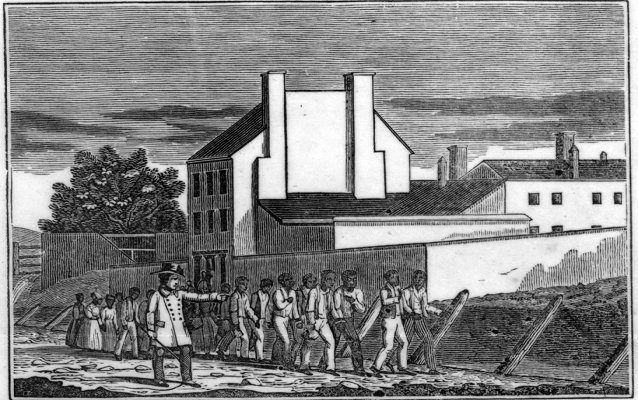Last updated: August 14, 2023
Place
Franklin and Armfield Office

Based in Alexandria, Virginia, Isaac Franklin and John Armfield were the largest traders of enslaved African Americans in the nation between 1828 and 1836. The men bought enslaved people at low prices in the Upper South and sold them at much higher prices in the Lower South. While Armfield remained in Alexandria to purchase bondsmen for shipment south, Franklin handled sales in New Orleans and Natchez. Franklin and Armfield orchestrated the trafficking of thousands of enslaved African Americans from their Alexandria office to the horrific labor conditions of the lower South in what has been called the Second Middle Passage.
Between 1810 and 1820, Robert Young, Brigadier General of the Second Militia of the District of Columbia, commissioned the construction of a house on Duke Street in Alexandria, Virginia. Shortly after completion, General Young was forced to sell it because of financial problems. In 1828, Franklin and Armfield leased the building for their slave-trading operation and later purchased the property. The main block of the house served as the firm's office and Armfield's residence. The two-story attached wing at the rear housed enslaved people at night. Both ends of the structure had partially roofed courtyards where captives passed their daylight hours. High walls of whitewashed brick surrounded these courtyards.
Every summer, slave drivers marched chained groups of enslaved people from Virginia through Tennessee to Mississippi and Louisiana. In the fall and spring, the firm used its fleet of sailing ships to traffic people to New Orleans. The firm had agents in almost every important Southern city. In the early 1830s, Franklin and Armfield bought and sold between 1,000 and 2,000 people each year.
____________________________________________________
Bill Keeling, male, age 11, height 4’5” | Elisabeth, female, age 10, height 4’1” | Monroe, male, age 12, height 4’7” | Lovey, female, age 10, height 3’10” | Robert, male, age 12, height 4’4” | Mary Fitchett, female, age 11, height 4’11”
- Enslaved children sold south by the Franklin and Armfield Office
____________________________________________________
In 1836, Franklin retired and Armfield gradually disbanded the firm. He sold the building to George Kephart, a fellow trader of enslaved people, who operated out of the building for a number of years before selling it to Price, Birch and Company. This new firm continued the trafficking of humans until 1861, when federal troops occupied Alexandria at the outbreak of the Civil War. During the war, the U.S. Army imprisoned captured Confederate soldiers in the slaveholding pens on Duke Street.
Franklin and Armfield profited greatly from their participation in the American slave trade. They amassed over $500,000 each. In retirement, Franklin, who had invested much of his wealth in land and his own personal slaves, lived the life of a typical wealthy planter. Armfield, who did not retire completely from the slave trade until the 1850s, invested his wealth in real estate and gave large sums to the University of the South before his death in 1871.
In the 1870s, Thomas Swann, a prominent railroad builder and political figure, purchased the property and tore down the slave pens. Over the years, the property has had several changes of ownership and has been used chiefly as apartments.
In 2017, the Northern Virginia Urban League owns the building, re-named Freedom House. It is a three-and-a-half-story structure of gray-painted brick with a large, three-story rear brick L-shaped addition. Despite alterations to both its exterior and interior, the Franklin and Armfield building still stands as a reminder of a dark chapter in U.S. and human history.
Click here to visit the museum
Sources:
1. Ball, Edward. “Retracing Slavery’s Trail of Tears.” Smithsonian Magazine, November 2015.
2. Virginia Foundation for the Humanities, “Franklin and Armfield,” African American Historic Sites Database.
National Historic Landmark Nomination of the Franklin and Armfield House.
National Historic Landmarks (NHLs) are historic places that possess exceptional value in commemorating or illustrating the history of the United States. The National Park Service’s National Historic Landmarks Program oversees the designation of such sites. There are just over 2,500 National Historic Landmarks. All NHLs are also listed in the National Register of Historic Places.
